 |  | ||||||
| Using an ancient Terran model, the Inter Planetary Alliance adopted a civilian employee pay schedule based on skill sets and time in service; Much like the militry, there are two distinctive schedules, one for those with strictly technical skills (or lack thereof), and the other for those with university degrees (minimum of a Bachelors). Generally, the individual is paid Rate plus (half number of years of service%), for example a SG-8 (Superintendent 1) with 15 years of service would make 169,844 per month. To promote from Technical Grades (TG) to Supervisory Grade (SG) requires at least 4 years of service in the TG system and possession of a degree (at least a Bachelor's Of The Art); It doesn't matter if you have the degree before you enter the system or obtain it while in the system. The system thus emulates the militry requirement to serve in the enlisted ranks for a period, then to attend OCS. This system was an attempt to shoehorn three systems around each other with the least amount to change to the largest single system (the militry) so that anyone could look at the other systems and instantly 'read' other members to determine who stood where in the pecking order, a vital necessity when various agency have to cooperate (such as natural disasters and evacuations). | |||||||
Undersheriff | |||||||
| Everything above this paygrade requires a degree; It may or may not be applicable to the duties performed. | |||||||
| Everything above these paygrades requires technical skills with certification or a degree; Technical skills may not be applicable to the duties performed (for TG system), degrees must be applicable (to SG system). | |||||||
| Everything above this paygrade requires technical skills with certification; Until you reach TG-08, it has to be applicable to the duties performed. | |||||||
Marshal/Correctional Officer (constable in some areas) | |||||||
| 1: Another system for General Titles is based on duties, with the number growing by the relative level; For example, an new hire lawn mower is a Lawn Maintenance 1 (TG-01); Next is Lawn Maintenance 2 (TG-02). A new hire nurse, assuming she's done her TG time, laterals over from TG-05 to SG; The newly minted SG-01 is Nurse (RN, LVN, or other) 1. In five years, she is promoted one paygrade to Nurse (RN/LVN/other) 2. Only at the SG-10 level is the titles locked in; Also, at that level they are the equivalent of Flag Rank officers, and as such are required to have a UGC Clariont Flag in their office along with their agency flag with hypocycloids equal to their flag rank (one for an SG-10, two fo an SG-11, three for and SG-12, and four for an SG-13). The star's colors are normally the agency colors divided as evenly as is possible (which is why most are two-color agencies). 2: Whereas most agencies the titles are a bit more flexible, law enforcement and fire service ranks are not, since they require the ability to identify ranking instantly across a wide range of systems (and across galaxies as well). Moreso, rank insignias are EXACTLY the same across the entire UGC, so as to keep those chains of command clear. However, in most departments certain ranks are skipped over (for example, there has never been a "Station Captain" in actual practice anywhere within the UGC's territory, and the UGC has never gotten around to defining a "Station Captain's" duties). However, exact imagery and colors are not so set in stone; For example, the Uvie use REF Officer style pips in gold in place of stars, Blue-on-black chevrons (pointed down), straight bars in place of bugles, and gold for the fire Department Officer insignias. It is not so important that the exact same imagery be used than that the imagery can be instantly understood. Some police and sheriff's departments split Lance Corporal and Corporal with a diamond or other emblem centered under the chevrons. In the rare occasion when other services ranks must be known (such as disasters), Supervisory Grade use a blue armband with a yellow numeral, Technical Grade use a yellow armband with a blue numeral on both arms; As appropriate, symbols indicating professions are included as an emblem to the right of or written words underneath the numeral are included. The purpose for the system was so that anyone from anywhere that knows the system can walk into any situation and instantly know who is in charge, who is intake, where medical staff is, who public relations are, etc. and do so with the most minimal information; It needed to be so simple even a below-average Pakled could understand it. Badges The UGC has promoted the adoption of a unified model of badges for paramilitry and emergency services personnel. Much like the use of armband the idea was to make the various agencies personnel instantly and unmistakably identifiable. They broke the various major groups down into the three main levels of governance (municipal and county, state, and global), private security, and private EMS. To help facilitate this the Council has approved grants to the various agencies to help pay for the changes consisting of half the initial cost of replacement the first year and a quarter the next provided the new badge meets the standards provided, in addition to a 2% business tax refund for 5 years for private employers. This would leave the agency to pay a quarter of the cost themselves, but this usually defrays the costs more than enough to justify the diffrence. Most governmental agencies have put off applying for the grant until they replace their badges in the normal course of business. Private enterprises tend to apply much sooner, since this is essentially free money, and most pad their expenses using unverifiable "costs" such as 'distribution expenses' (which are typically only investigated when the claims close in on 10% of yearly taxable income). | |||||||
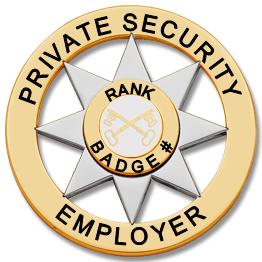 | 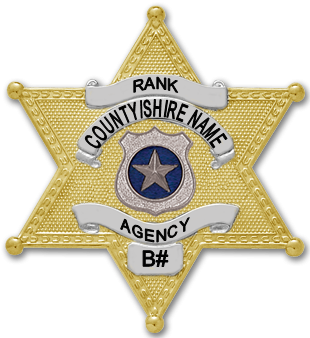 |  | 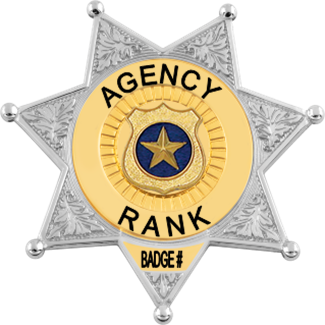 | ||||
| Security Guards serve to protect their employing or their client's property. The simple standard for security badges was set at a badge with a circular outer edge. In the 2090's the IPA passed an act making security part of the First Responder hierarchy, but also set standards for guards (primary the requirement of a high school diploma or GED and through mastery in speech and writing of the local language). | County/Shire Law Enforcement serve an incorporated geographic area. They typically take authority over jails, probation and parole, marshals, etc. Most of these are headed by the country Sheriff, who is elected throughout the UGC. Any variety of 6 point star was set aside for country law enforcement. | Municipal (city) law enforcement serve incorporated areas. Because cities tend to have the highest population per acre, these tend to be the larger agencies per capita and have the widest variety of duties (SWAT, bomb squad, etc.). Any variety of shield or obolid badges were set aside for municipal law enforcement. | State Law Enforcement serve the larger state (a collection of counties). Most state law enforcement include prisons. This category includes national and planetary agencies, including customs enforcement in systems that have their own duties houses. Any variety of 7 or more point stars were set aside for state law enforcement. | ||||
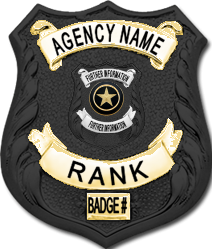 | 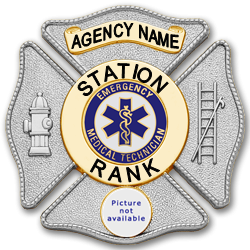 | 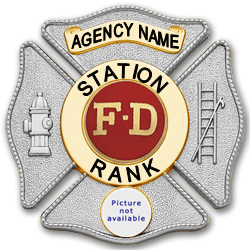 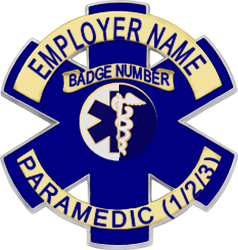 | |||||
| UGC Law Enforcement mostly serves as oversight for regional LE and to facilitate the return of fugitives from justice. With the exception of Militry Police, the GIS, and Prison Colony officers UGC global badges are gold and/or silver plates on a black badge; During development of the program the GIS pointed to their own badges as an example of something others should not do, as it made reading the barges difficult. | EMS provides immediate medical aid; Qualification as a paramedic is a requirement to become a fire fighter. The first iteration of the requirement read "Maltese Cross," but has since been changed to "cross or square form" because not every speices understands what "maltese" means. Paramedics with a Caduceus | Fire fighters fight fires; That might seem simple enough but is the higher level of training as qualification as EMT is as a prior requirement. A firefighter's badge is mostly the same as a paramedic's, except in the seal which is to show a fire symbol rather than medical and predominantly red to differentiate them from paramedics. The change from Paramedic to Fire Fighter is not considered a promotion, though it can count towards promotion during a career. | Private EMS service typically work for hospitals, though they can be chartered as well. 75% of paramedics across the empire work for private service ambulances, with about 25% working for hospitals. The badge may be any variety of generally round shape other than ovoid; The example here is quite common, since it incorporates a Star Of Life (part of the Rod Of Asclepius) into the base. | ||||